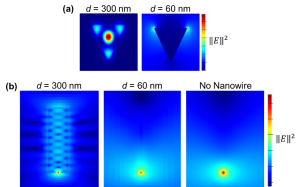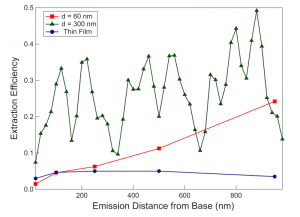Studies of Light Extraction in GaN Nanowire-based Light-emitting Diodes
- Category: Materials, Nanotechnology, Optics & Photonics
- Tags: jordan chesin, silvija gradecak
Nanowires are an exciting architecture for light emitting diodes (LEDs). To address the challenges of solid state lighting, III-V nitride nanowires have demonstrated many advantages over standard thin-film architectures [1] . The one-dimensionality of nanowires makes them inherent waveguides [2] .
In designing nanowire-based LEDs, it is important to consider waveguiding and nanowire geometry. GaN nanowires grown in the m-direction are triangular in cross-section. Finite difference time domain photonic simulations were used to calculate electric-field intensities in such nanowires, with varying sidewall lengths, d, assuming lossless 1-µm-long dielectric nanowires with a refractive index of 2.6 suspended in air. At the emission wavelength of GaN nanowires (≈380 nm), m-directional nanowires with sides of less than ≈150 nm support no waveguided modes. Figure 1a demonstrates the difference in light confinement within the nanowires with (d = 300 nm) and without (d = 60 nm) waveguided modes. Figure 1b contrasts propagation in the axial direction of the nanowire as compared to just the dipole source. Light extraction was considered for vertically oriented nanowires on a silicon substrate, with varying emission source positions. Figure 2 summarizes these results and compares them to the thin-film case. Emission at the silicon substrate has low extraction efficiency due the higher index silicon absorbing light from the GaN. In the waveguided case, extraction is generally higher, as most of the light is guided within the extraction cone; however, due to differences of coupling into the guided mode with emission distance from the substrate, the extraction efficiency varies substantially with position. With emission near the tip, the waveguided case is less extracted than the non-waveguided case due to more reflection. For both of the nanowires, extraction efficiency is greatly improved over the thin-film case, warranting further investigation into nanowire-based LED design, which is ongoing.
- Figure 1: Comparison of electric-field intensity profiles in the cross-section of the nanowire (a) and the along the axial direction of the nanowire (b). Both cases demonstrate that for larger nanowire side-lengths, d, waveguided modes exist and are confined within the nanowire, while for smaller nanowires with no supported modes, emission and propagation is notably similar to without the nanowire.
- Figure 2: Extraction efficiencies as a function of emission source distance from the substrate interface in 1-µm-long nanowires for nanowires with (d = 300 nm) and without (d = 60 nm) guided modes as compared to in a 1-µm-thick film, on a silicon substrate. Both nanowires demonstrate improved extraction over the thin-film case by overcoming the light extraction cone.
- Y. Huang, X. Duan, and C. M. Leiber, “Nanowires for integrated multicolor photonics,” Small, vol. 1, pp. 142-147, Jan. 2005. [↩]
- A. L. Henneghien, B. Gayral, Y. Désières, and J. M. Gérard, “Simulation of waveguiding and emitting properties of semiconductor nanowires with hexagonal or circular sections,” Journal of the Optical Society of America B, vol. 26, no. 12, pp. 2396-2403, Dec. 2009. [↩]

